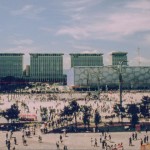A Day in Beijing 2014: Progress
As my flight was descending to land in Beijing, the cloud cover obscured visibility until the plane came close to landing. In fact, the grey pall was pollution. To balance that striking drawback, the city’s development was clearly planned with green areas near apartment complexes and streets lined with trees and flower-beds. Despite a six-lane highway running from the airport to the city, it took my taxi 45 minutes to travel the 10 km to my hotel. On the next morning, a strong, chilly wind cleared the air and the sun shone on the city.
The last time I visited Beijing was during the Olympics in 2008 when I was stunned by the dramatic modernization and architectural splendor of the city since my previous visit in 1996. I was prepared to be astonished again, but I wondered how much more could be done. Well, my surprise was different, but equally amazing. For the 2008 visit, I lodged in a friend’s apartment in the 3rd Ring Road circling the city. Although the center of the city showed few signs of a developing country, by the 3rd Ring Road the third world was evident.
On this visit, my hotel was in the 5th Ring Road area, surrounded by blocks of apartments and huge shopping malls. Walking around the neighborhood, I saw tiny signs of the third world—aging, usually small, structures, a small food stall near a bus stop or an occasional three wheeler carrying cargo, even a bicyclist or two. Otherwise, the broad roads were heavily trafficked by cars, pedestrians were well dressed and malls busy with shoppers. Judging by people who came for breakfast, I was among the very few foreign guests in my hotel. If China is in a middle-income trap as some commentators say, it’s a pretty impressive trap.
The area around Tiananmen Square had not changed much. Well, there wasn’t much left to change after 2008. But the architecture, exhibits and display at the National Museum were splendid. I spent a long time walking through the main exhibit of Chinese history, from ancient times until the end of the Qing Dynasty in 1911. The display was arranged to ease viewing and comments were in both Mandarin and English. I was surprised to see so many intricately designed bronze objects dating back to the second millennium BCE. Clearly, China’s economy was huge and highly developed for the era. The greater surprise was the two galleries devoted to Buddha sculptures and Thangkas in a State with an atheist ideology. Some of the Buddha statues, with Chinese characteristics, were gorgeous as were the Thangkas. Many visitors were paying obeisance to these images suggesting a revival of religious feeling. That the government allowed these exhibits is a sign of openness, but full access to some innocuous websites such as facebook and google seemed blocked. I hope China manages the transition to more freedom and openness as well as it has to developed country status and an emerging world power.
I’ve read many articles comparing India and China’s development, some suggesting that India may overtake China in the near future. I’d like to smoke what they are to see the almost total chaos of India in any way catching up with the orderly progress of China. In addition to driving in a car in Delhi and Beijing, one just has to visit the National Museums of both countries to gauge their relative progress.

